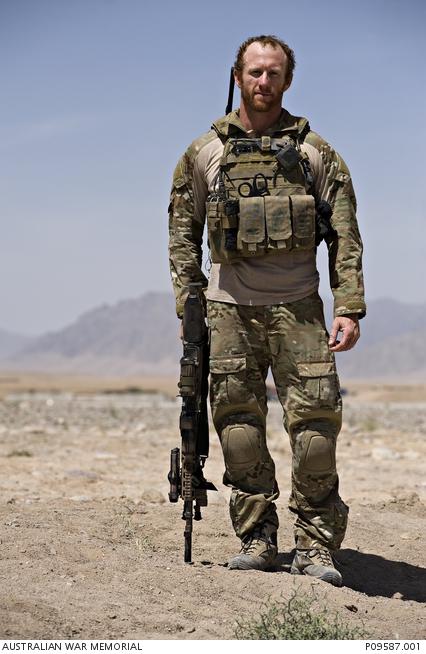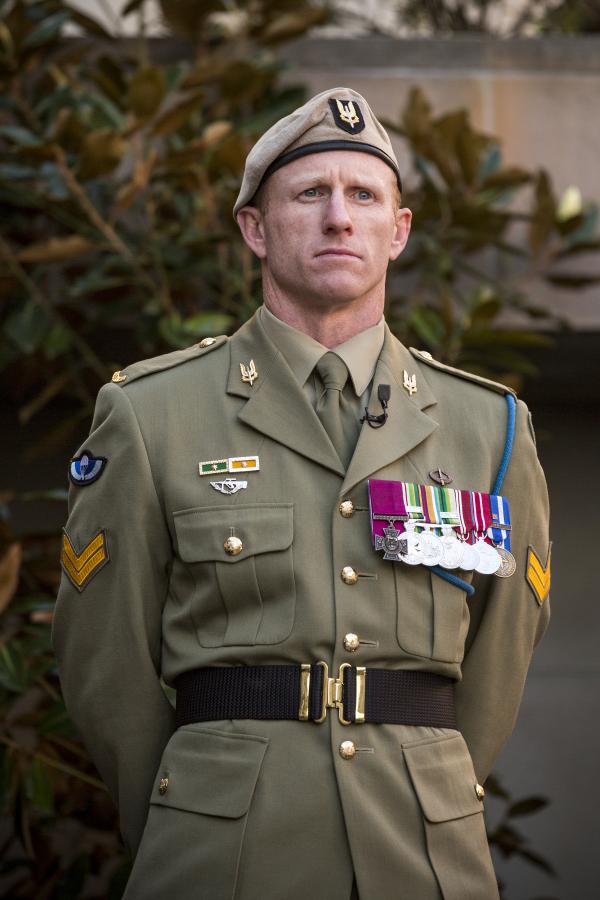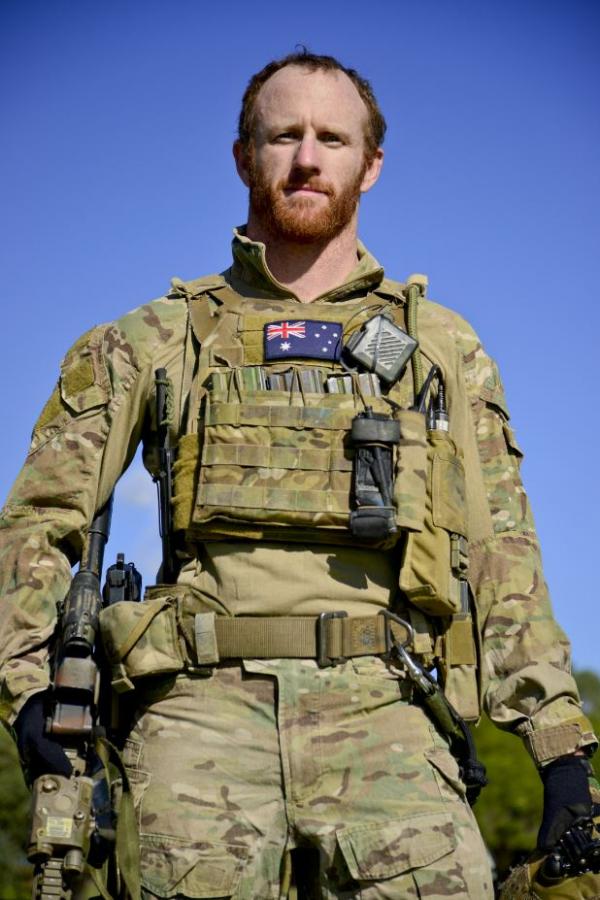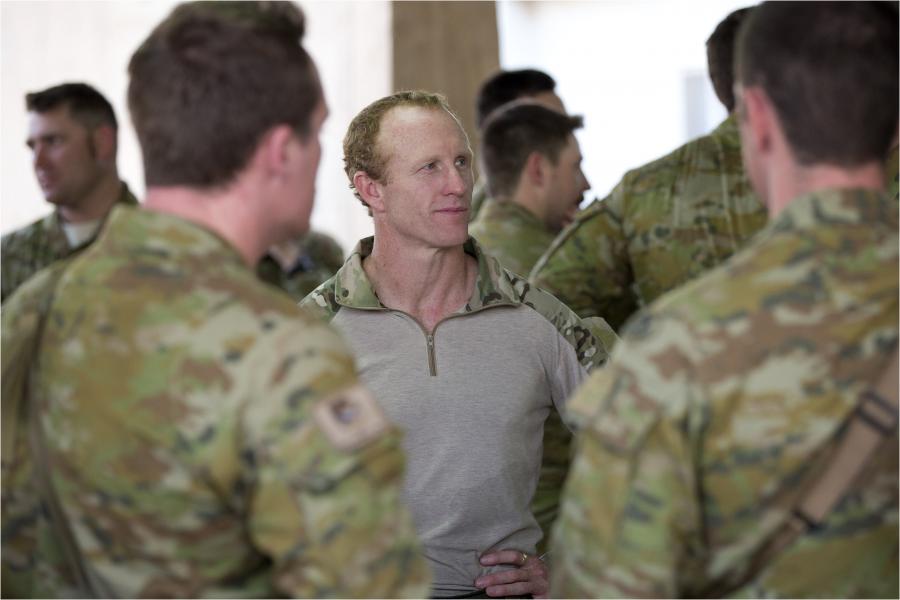'We don’t leave anyone behind'

Mark Donaldson doesn’t see himself as a hero. But on 2 September 2008, the then Trooper Mark Donaldson made a split-second decision that would change his life.
His extraordinary courage in rescuing a wounded Afghan interpreter during an ambush in eastern Afghanistan saw him awarded the Victoria Cross for Australia for his actions that day, making him the first Australian since the Vietnam War to receive the nation’s highest award for bravery.
It was 10 years ago now, but the former SAS soldier can recall the details – the sight, the sounds, the smells, and how it felt – as if it were yesterday.
“We’d taken out quite a lot of the leadership from the different networks … and we were just really chasing the cream on top, and that led us to a place about 80 to 100 km from where we hung out to an American special forces base [Anaconda, north-east of Tarin Kot],” Donaldson said.
“The Americans said there are bad guys up in the north, there are bad guys out in the east, and in the south and what not, so we came up with a plan to send them out as bait basically in their cars ... We were up in the hills the night before [and the idea was] we will get the bad guys when they come to get the goodies … And it worked really well.”
The patrol then focused on the Ana Kalay Valley, near the village of Khas Uruzgan, a known hotbed of Taliban activity.
“So, we said, what can we do? Let’s replicate something similar … Was there a risk there? Yeah, there was a risk there… They were talking about attacking us and what not, but there weren’t really the signs there that this was going to happen,” he said. “We got off their cars and went into a position to help overwatch their move… They pushed seven guys from the top of the network straight into the hills, and they ran straight into the Aussie patrols. We took out the whole top echelon of that network, so it was successful.
“On the way back from our position, we hopped back in the vehicles … to head back to the operating base… I remember just before we came off that hill … watching this guy [in] … dark robes come out of the hills on the northern side of the valley on this high ridge line…. I remember discussing it with my mate… We both thought that’s a bit weird, but what can you do? What can you prove? Nothing. People come out of the hills all the time up there, but we noted it, and we passed it on, but it was one of those little things you remember.”
They were heading back through the valley when they were ambushed and attacked from four different directions near a densely wooded area known as the green belt.
“I was in the last vehicle with our patrol,” he said. “[There was] machine-gun fire, heavier calibre machine-gun fire … [and] rocket-propelled grenades, I remember them flying through the air… When one flies past your head, close enough, it makes this strange sort of … whooshing, whizzing kind of sound and I’ll never forget what that sounds like. It’s not a bad thing. Don’t get me wrong. It’s just something you remember.
“The rockets are exploding around us, and I remember watching the shrapnel kick up through the dirt and the dust. I grabbed a rocket launcher of our own, moved my way to the flank of the vehicle, and started to shoot that off… Some of the rockets were effective, some of them weren’t, but it was enough to maybe stop one or two of the firing positions, at least for a little period of time, from shooting at us.
“I got my gun and we started to continue fighting … Myself and a young guy, we’d moved away from the car and we were trying to use this small knoll as cover and we were having a quick laugh about the whole situation.
“Humour is so important, and I said to him, ‘How lucky are you, mate?’ It’s day number three. It’s his third time ever. He’d never been on operations like this: he’d never been on operation… And he’s into it already and just then … a big burst of machine-gun fire ripped straight between our positions … from behind us, so we spun around and looked back up to that hill, where that guy had come from up on that ridgeline.”
An American Joint Terminal Attack Controller coordinated a gun run from two F/A-18 Hornets to help suppress the Taliban fire coming from the north.
“The situation was changing very quickly,” Donaldson said. “They were dropping ordnance, [but] had to leave [and] we were getting mortared for a little while there as well. I remember lots of rockets coming in at one stage … and I was fighting from the side of the vehicle. I felt being a moving target was going to be harder to hit … but there were lots of rounds coming in. You’d be on one side of the vehicle and you’d see them kick up the dust around you, and you’d hear them hitting the car next to you, and you’d run around the other side, and try and engage the guys on the hill.”
He will never forget the “snap” sound of the rounds passing straight over his head.
“We started to take more casualties, and a mate of mine got shot through his legs,” he said. “It took off a fair chunk of his right calf, and the next one went through his left leg, which made him hit the deck. He was trying to stand up, and run towards the car, and he couldn’t. He was on his knees, and he was on his elbows crawling after that car, yelling out for it to stop. Eventually they heard him, and they stopped and an Aussie guy jumped out and dragged him into the safety of the vehicle.”

Photo: Defence
Donaldson and two other Australian patrol members ran out into an exposed position to draw fire away from the vehicles and their wounded.
“Myself and a couple of others pushed away from the cars to lie in a small ditch,” he said. “The 2IC was running around doing a fantastic job, handing me ammunition, asking me if I needed any more, telling me what he wanted me to engage, and what was there, and keeping me on track.
“At that stage there’s rounds coming in from the north, rounds coming in from the south – gunfire, bullets – and at one point these two Apaches came in and flew around. Apaches have got big guns, big missiles that change the tide of a battle … and I remember watching them fly away and just going, holy shit, I’m pretty scared, this is what being scared in a firefight is…
“Not that I hadn’t been scared in firefights and things before, because I had, but not like this … I thought holy shit, you know, we’re not getting out of this one: no one’s coming to save us, no one’s coming to save the day, and I had to have this quick conversation with myself about what’s important now … I just want this to all go away, but that’s not going to happen, so I can’t give up. I made a choice, I made a commitment to be here, and the main thing that’s happening right now is that we need to get my mate who’s wounded onto the car, and we need to get up, and we need to start moving. And that’s what got me out of the ditch.”
They managed to get the wounded soldier into one of the vehicles, but Donaldson found himself exposed as it took off.
"I remember the bullets were coming in quite heavy, sort of chasing me around a bit, until the next car caught up, and then we continued to fight,” he said. “One of the guys then took a bullet … and the next bullet struck him underneath his armpit, went through is lung, his liver, his spleen, his stomach, his pancreas, his upper intestine, and something else I’m sure. It pretty much didn’t hit his heart and his other lung, and came out his left hip… The American medics [who were with us] did another fantastic job of treating him. It was too hot to bring in air and medical evacuation in, so we had to just bung him in the car and say [to him], you are going to have to suck it up...
“We got to another stage where … lots of rockets came in and wounded some more guys in front of us quite badly. They smashed the first car … the second car, and the third car, and I thought this is insane. They know exactly where this spot is, they know exactly how far it is, so I said to the guy who was with me, ‘I’m going to run through there first, and try and draw some fire so the guys in this car don’t get hurt more than what they already are.’
“He said, yeah, all right, I’ll come with you, and we just ran through. I remember the bullets coming in and hearing the rockets passing over us, and we ran for a reasonable size rock about the size of a café table and we were sitting behind that …
“It was enough to confuse the enemy: it was enough to make them think, which one do I shoot, the people or the car? And they didn’t get to shoot either of us. But then we had to make a mercy dash … to run back to the cars to fight alongside those, and the fighting just sort of went on and on. You’d be on one side of the vehicle shooting, and it would just get too heavy, and you’d run around the other side. There were three of us fighting pretty much alongside all through that period, and I just remember being really hot, really, really, hot.
“My gun was starting to run dry – I’d already gone through six mags – and I was starting to take magazines off the wounded guys out of the back of the car. One of the Americans had been killed and some more guys were getting wounded … I remember the bullets chasing me and I remember something brushing … past my pants and I got back on the other side and continued fighting again … There’s bullets coming from the front and the sides, and the Afghans sort of locked the car down, and … they just weren’t going anywhere.
“Some more rockets came in, and two guys got blown out of the back of it, one was an Afghan … interpreter, the other was an Aussie engineer. From what I saw the Aussie got up and started to move, but the Afghan was getting left behind.”

Photo: Pan Macmillan Australia
Donaldson then sprinted 80 metres over exposed ground while under intense fire to recover the wounded interpreter who was lying face down in a pool of his own blood.
“I said I was going to go out there and get him … and then I took off,” he said. “I’m getting chased by bullets, and I got to him, and there were bullets kicking around us … I started to drag him at first – and I’m not a massive guy – so it wasn’t really working out. I got him to his feet, with my arms sort of underneath him, half carrying, half dragging, and I just thought: what now? Do I leave him here? Do I use him as a shield? Do I just save my own skin? Or do I get him to that car that’s driving away from us? And that’s the only thing I could really focus on – that vehicle.
“His face was really bloodied and messed up and he was trying to talk to me. He was trying to tell me his eyes were hurting – ‘I know your eyes are hurting, mate, you’ve been wounded, it’s all right, let me get you to the vehicle’ – but I finally got him there, managed to wrap a bandage around him, and mucked around trying to get him into the car.
“I was really, really dry, and my lungs were burning, massively. And I distinctly remember this because it took me about five or six goes of just swapping from side to side to side of the vehicle. I was that tired – and I don’t tell anyone this – but I was that tired, I was leaning against the vehicle as it was moving, and just moving my legs, and my 2IC came around and said, ‘Man, just keep running.’ He was worried I was going to fall over and get caught up underneath the car.
“I got the guy in the car and came to the back of the vehicle and our mate was there – his third day ever – blood coming down his face, and I said, ‘What happened to you?’ and he said, ‘I’ve been shot.’ I said no shit, right – he had a hole through his hat ... and it had just grazed his skull and split the top of his head open. He was lucky it didn’t dig in and bury in, I said, ‘Are you all right?’ And he said, ‘Yeah I’m fine,’ and he started engaging some guys as the cars took off.
“We were at a full sprint – what we had left in us – and we were grabbing onto the aerial, the antenna, and that was shot off, so there was only half of it left. I managed to throw my gun in and climb up, and he was running behind me. I grabbed his gun, managed to grab his arm and pulled him into the vehicle.
“In the back of that car was the wounded Australian who had been shot through the leg and the hand, the wounded Afghan who’d been shot through the face, a wounded American who’d been shot through the arm, and a dead American.
“We had to lie on top of those guys, which exposed us above the rear of the vehicle, to continue fighting. I jumped on the gun that was [mounted] on the back because … we were getting shot at still… It felt really good, right. This is better, this is more like it. I should have a machine-gun in my hand, not this little pea-shooter. And then it stopped. I went through the stoppage drill to fix it, and it stopped again. I put my hand around the front to change the setting on it, and it had been shot through … so that was useless, so I just lay down again on the back with all the guys. The Afghan guy kept trying to sit up, and again, it’s one of those things you remember. He’s sitting up, and he’s sticking his head up above the parapet, and he’s saying, ‘I’ve been shot in the face,’ and I’m saying, ‘I know you’ve been shot in the face, mate, I can see you’ve been shot in the face…’
“I’d push his head back down, and he’d stick it back up again – ‘Mate, I know you’ve been shot in the face, but you’re going to get shot again if you don’t keep your head down’ – and I ended up having to put my foot on his head to keep it down.”

Photo: Defence
By the time they finally made it back to forward operating base, the relatively small force of 37 coalition troops had spent almost four hours extracting itself from an ambush involving an estimated 100–150 insurgents.
“It’s going to sound dumb, but it was almost like one of them Vietnam movies,” Donaldson said. “It was about four kilometres long, the ambush, and from first bullet to last bullet it was about three and a half hours of constant fire…
“We were smashed up pretty bad. We had three air and medical evacuations that night, and the last guy I helped put on the helicopter was the Afghan guy that I picked up. I put him on, and that was the last time I saw him. I didn’t see him again.”
The citation for his Victoria Cross said his actions that day displayed “exceptional courage in circumstances of great peril” but for Donaldson it was a case of simply doing the right thing.
“We don’t leave anyone behind,” he said. “It doesn’t matter that we only knew him for five days. It doesn’t matter that we called him Chavez: Chavez because he looked like Lou Diamond Phillips in Young Guns II. He was an Afghan guy that was one of us. He was with us, and he was out there fighting with us, and I respect that. I would hate to be lying face down in a pool of my own blood getting left behind on a battlefield.”
He admits though that there were times he didn’t think they would make it out alive. “When I was lying in that ditch watching the Apaches fly away, [and] when I ran back and got him, I was seriously questioning whether I was going to make it out of there with him,” he said. “You have those moments of doubt, but then you think: let’s worry about what needs to be done.
“I guess it’s one of those things: any day that you go out there, you might not come back, but I very rarely thought about it like that.
“Something I definitely learnt from that day was: no matter what mission I’m going on, I’m coming back, and I’ll do everything I can to get everyone back…
“There was no way I’m not coming back from this, even if it is in a bag, but I think you’ve got to have those tough mental conversations with yourself. You’ve got to come to peace with what’s going on over there. … There’s bullets flying around, you’re getting shot at, somebody’s going to get hit, so come to peace with that.”
Corporal Mark Donaldson will deliver the Commemorative Address at the 2019 Anzac Day Dawn Service at the Australian War Memorial.
His Victoria Cross is on display in the Hall of Valour, and his book, The Crossroad, A Story of Life, Death and the SAS, published by Pan Macmillan, is available in the Memorial shop.